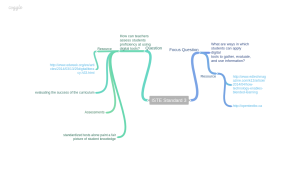ISTE 3 Focus: What are ways in which students can apply digital tools to gather, evaluate, and use information?
Question: How can teachers assess students proficiency at using digital tools?
This weeks readings were very interesting, as well as applicable to my current studies. In the article How Teaching Enables Blended Learning, the author Wylie Wong looks at the changes that are taking place in one California school district. When the district hired a new superintendent, they asked each school the same question, “If you could design a school of the future, what would it look like?” The schools all met and came up with answers, they wanted to implement blended-learning. Blended learning enables students to complete work in the classroom and also use online learning tools as well. With the use of the Blended learning model, students are able to receive a more customized education curriculum. One of the principles named Alicia Padilla said, “students take a formative assessment online, and depending on how they perform, the software generates a learning path for them, they get customized digital instruction.” (Wong, 2014). Having participated in blended learning classroom in college, I do feel that they are quite useful for utilizing time. I am able to study at home around my own schedule, but I am also able to engage in weekly face to face meetings with my teachers and classmates. I found this to be an extremely successful way to learn.
The article that I looked at this week titled Movement Grows to Assess Students’ Digital Literacy, by author Robin Flanigan looks at the ways some high schools are using digital tools in the classroom and how teachers are evaluating the success of the curriculum. In Marlborough, Mass a group of 10th grade students put on a formal presentation during a technology conference. The students taught a hands-on lesson to teachers attending the conference. During their presentation they should how they use a variety of digital tools, application and simulations that support their work while at school. Their teacher Alexia Forhan said, “Education used to be about learning something and spitting it back to me. Now, it’s about understanding and application. The more students teach me and others what they know, the more I feel they’re truly learning.” The article also considers the points that have recently been made by state-led consortia, technology experts and teachers would like to see students use of technology assessed. Wendy Dressier, who is the chief innovation officer for the International Society for Technology in Education, would like to see more alternative assessments given to students. She does not feel that standardized tests alone paint a fair picture of student knowledge. I agree that especially if a blended classroom is being used, teachers should be assessing how their students are growing with technology.
References:
Wong, W. (2014, April 1). How technology enables blended learning. Retrieved July 23, 2015, from http://www.edtechmagazine.com/k12/article/2014/04/how-technology-enables-blended-learning
Flanigan, R. (2014, March 10). Movement Grows to Assess Students’ Digital Literacy. Retrieved July 22, 2015, from http://www.edweek.org/ew/articles/2014/03/13/25digitalliteracy.h33.html
